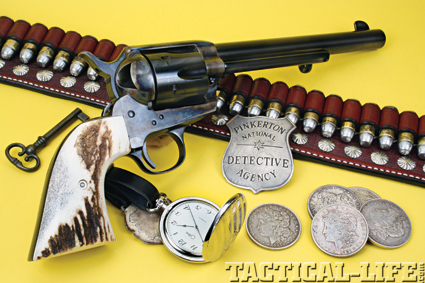The Great Western II .44 SPL with Turnbull color casehardening and American elk grips from Eagle Grips is a handsome six-shooter that performs as good as it looks.
The Great Western II .44 SPL Welcomes Modifications Galore
We all have favorites, it doesn’t matter whether it’s cars or flavors of ice cream; if there’s more than one to choose from, there will be one you like better than the others. Along those lines, as a shooter, I’ve never shot a caliber I didn’t like, but I’d be lying if I didn’t admit to a favorite. That’s the .44 Special.
Since I was 19 years old I’ve always had a single-action capable of shooting .44 Special ammo, and those guns have been my usual choice for a day in the woods or for casual plinking sessions. But I rarely used .44 Special guns for Cowboy Action Shooting (CAS), relying instead on my .44 Colt conversions to fill that ticket. However, this year I spent a lot of time testing .44 Special ammunition for one of my black powder columns, and after shooting hundreds of rounds, I had fallen in love with the .44 Special all over again. I was overcome by the undeniable desire to use that great cartridge in CAS matches.
Advertisement — Continue Reading Below
That posed a bit of a problem because I didn’t have a matching set of single-action revolvers chambered for .44 Special. I had a nice 7.5-inch barreled SAA clone with European stag grips that I’d used for the black powder load test. I could have paired that up with my old faithful Hawes Western Marshal, but the Hawes barrel is 6 inches long. It has a different look and feel from a conventional SAA clone. I figured I’d just have to buy myself another 7.5-inch SAA clone.
I know some of you are thinking you’d like to have that sort of problem. However, it wasn’t as easy for me as you might think. First of all, .44 Special isn’t all that common a single-action chambering. And in this case, I had determined I wanted my 7.5-inch barreled .44 Special to be one of EMF’s Great Western II single-actions. And they don’t come in .44 Special at all.
Enter the Great Western II
Despite that, I was hard over on this gun being a Great Western II .44 SPL. And I’ve been a fan of the Great Western II since EMF first introduced them nearly six years ago. They are the closest clone you can buy to an actual second-generation Colt SAA. In fact, the Great Western II, out of the box, is notably better that some actual 1990s Colts I’ve shot. Most second-generation Colt parts fit perfectly on Great Westerns, and that can be handy.
Advertisement — Continue Reading Below
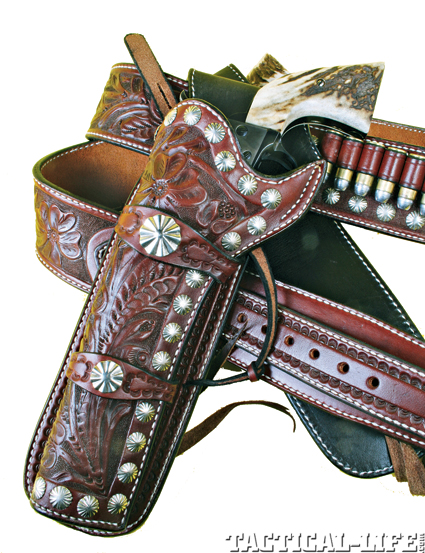
Besides being beautiful, this Rod Kibler rig is a fully practical outfit. The belt is lined with rough-side-out leather to keep it from slipping, and the fully lined holsters are solid as a rock, affording a smooth draw. The extra 2” drop on the holster makes pulling those long 7.5” barrels as easy as drawing 5.5” guns.
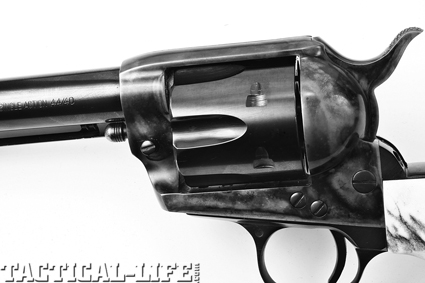
Advertisement — Continue Reading Below
EMF offers the Great Western II with a custom color casehardened finish by Doug Turnbull. This option is well worth the money. Doug’s color casehardening is a work of art.
So, there I was with an itch for a Great Western II chambered for .44 Special and no way to scratch it. It was a dilemma, but I’m not an Eagle Scout for nothing. EMF carries the GW II in .44-40 caliber, and they also sell the GW II chambered for .357 Mag. A quick phone call to Will Hanson at EMF confirmed that they could fix me up with a Great Western II chambered for .44-40 along with a spare cylinder chambered in .357 Mag.
Cylinder
When the revolver and spare cylinder arrived I immediately reshipped them to Alan Harton of the Single Action Service, who turned the spare .357 cylinder into one chambered for .44 Special. That process ended up being a little more involved than we expected, which is why it’s a good idea to use a top pro like Alan.
Advertisement — Continue Reading Below
As it turned out, the spare cylinder wasn’t perfectly round. It had a high point that was binding against the frame. Alan machined the .357 cylinder concentric to the base pin. Then he chambered it for .44 Special and set up the gun so both the timing and barrel cylinder gap were right for both cylinders. After that he polished and re-blued the new .44 Special cylinder and shipped it back to me.
Grips
Even though I was eager to take it out to shoot, the Great Western II had one more trip to make before it was ready for prime time. So I slapped another address label on the box and sent it to Eagle Grips where Raj Singh outfitted it with a set of American elk grips.
In a few weeks it was back home and I could finally sit down to admire it. It was worth the wait. This is a beautiful firearm. The 7.5-inch barrel gives it the sleek look I admire in a single-action. I had chosen the custom-finished version of the GW II, and it was well worth the extra money. The barrel, ejector, triggerguard and backstrap are highly polished and finished in a nice dark modern blue. That’s nice, but the really special touch is the real bone color casehardening done by Doug Turnbull.
Advertisement — Continue Reading Below
Elk Grips
The elk grips from Eagle Grips complete the elegant appearance of this Great Western II. These pistols come with a set of nice poly-ivory grips, but I think a firearm this fine deserves a grip made of a natural material. I was interested in stag grips, but Raj convinced me to try elk instead. I was a little hesitant because I’d been unimpressed with the quality of elk grip panels I’d had seven or eight years ago. But Raj convinced me to give elk another chance. “We’ve got this material figured out now. You’ll be impressed,” he said.
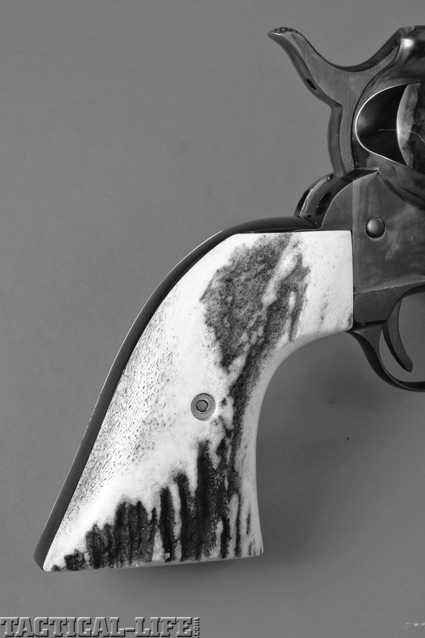
The right grip panel has about 50 percent bark showing on the Eagle Grips American elk grip panel. The bark is remarkably like Sambar stag in its shape and color.
Advertisement — Continue Reading Below
He was right. These elk grips are drop-dead gorgeous. In fact, I think most people would think they were Sambar stag, and I’d never have said that about elk grips five years ago. Sambar stag is the gold standard of grip making, but it is scarce, and correspondingly expensive. Elk is a bit less dense than Sambar, and the price is very reasonable in comparison to Sambar stag.
My grips have about 50 percent coverage, with bark on the right side and a bit more on the left side. The color of the bark on the left panel is just a bit lighter than most Sambar stag, and a little typical elk porosity shows along the back of the panel. But, other than that, it looks remarkably stag-like. These are the nicest elk grips I’ve ever seen.
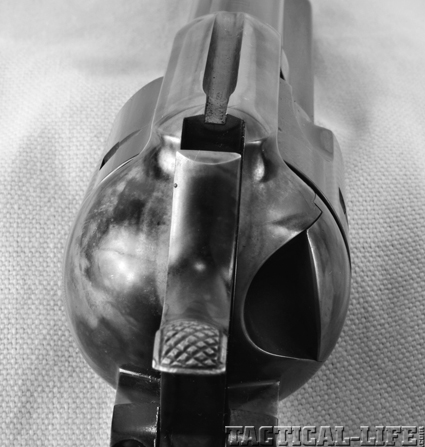
Advertisement — Continue Reading Below
The generously proportioned sights on the Great Western II are far and away superior to the sights on most single-actions. They are very easy to see, even with middle-aged eyes.
More Changes
I made two other changes to the Great Western II .44 SPL before taking it out to the range. I’m not fond of the small, crescent-shaped ejector rod head on second-generation Single Action Army revolvers. I’ve always been much more partial to the generous sized, bull’s-eye ejector heads on the early Colts. So I ordered an Uberti bull’s-eye ejector rod from VTI Gun Parts in Connecticut. The Uberti rod was just a bit long, so I shortened it up to fit the Great Western II .44 SPL.
I also got rid of the Great Western II’s base pin. This is the only part of the GW II that I actively dislike. It has the requisite two notches mandated for import into the United States. One notch is the safety position that will prevent the hammer from falling on a round during the drop test. The other notch is the normal use position. I’m not a fan of two-notch basepins, but in this case it’s worse than that. The notches are just on one side of the pin, which means the pin has to be inserted with the correct orientation of the grooves to the crossbolt. That is awkward at best, and darned near impossible with greasy fingers during a match.
Advertisement — Continue Reading Below
I replaced the Italian base pin with a genuine Colt second-generation base pin. The Colt part fit like it was made for the Great Western II .44 SPL, and it is more pleasant to use than the original pin.
Carry Rig
I knew this pistol would be something special, so when I ordered it I also contacted Rod Kibler of Kibler’s Saddlery to build a rig worthy of this sixgun. Rod outdid himself. The belt and holsters he built for me are nothing short of stunning.
The leather is a deep shade of reddish-brown. The holsters are lined in smooth black leather, while the belt is lined with rough-side-out leather to stay in place. The rig is fully carved with a floral pattern over a stippled background. Then the whole rig is accented with fluted conchos and spots. Thirty bullet loops, sized for .44 Special, complete the outfit.
The holsters themselves are individual works of art. Even the toe-plugs are accented with nickel-plated spots. Because I was dealing with long-barreled sixshooters, I asked Rod to make the holsters with 2 inches more drop than usual. This makes those 7.5-inch barrels draw as easily as 5.5-inchers.
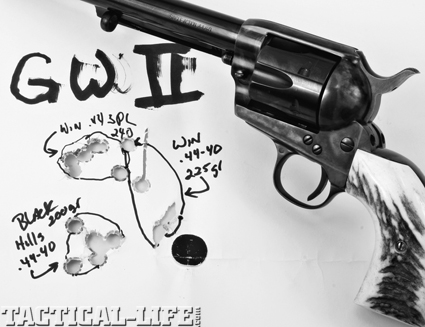
The Great Western II .44 SPL delivered 1” groups with most .44SPL and 44-40 ammo tried.
Range Time
Cosmetics are nice, but a gun has got to perform to be any good. And the Great Western II proved itself to be very good indeed. This is one of the few sixguns I’ve handled that didn’t need an action job to run well.
In fact it is every bit as smooth as its left-hand holster mate, except Mr. Left-side required the services of a very good pistol smith to reach the same level of silky smooth perfection. The trigger pull on my Great Western II is a clean, creep-free, 3 pounds on the nose, as measured by my RCBS trigger pull scale. That pull weight is just about ideal for most shooters.
Sights
The sights on the Great Western II are also different from the sights you’ll find on most single-action clones. The front post sight is thick with no taper. The rear sight is a generous, square-cut notch. That combination means these sights are easy to see, even with middle-aged, bifocal-wearing eyes like mine.
I took the Great Western II to the range on consecutive weekends. The first session was to see what it could do with factory loaded smokeless ammunition. The second trip was to see how it digested black powder handloads. And let me tell you, this gun can shoot.
Shooting Smokeless
For the smokeless session I shot Winchester 240-grain .44 Special Cowboy ammunition, Winchester 225-grain .44-40 Cowboy ammunition and Black Hills 200-grain .44-40 rounds. The worst I did shooting any of these loads was a 2.5-inch group while shooting off-hand from 15 yards. The Winchester 225-grain .44-40 turned in that performance, but even that round averaged 2 inches over the course of a box of ammo. Velocity with that Winchester round averaged 691 feet per second (fps).
Ordinarily, I’d be pleased to shoot 2-inch groups, but the GW II taught me to raise my expectations. When I shot the Winchester .44 Special Cowboy loads I found most of my bullet holes were touching or overlapping on the paper. Even with the heavier bullet these rounds were moving along at 778 fps, faster than the lighter bullets in Winchester’s .44-40 ammo.
I didn’t measure every group as I shot a box of this stuff, but I doubt that many were over an inch. The group pictured is typical, with four holes touching and one round that opened the group up to an inch in diameter. On one target I had 20 consecutive shots inside a 1-inch circle, just a ragged hole by the end. The heavier bullets printed about 2.5 inches above my point-of-aim. Everything I shot printed a couple of inches to the right.
Black Hills 200-Grain .44-40 Ammo
The Black Hills 200-grain .44-40 ammo proved to be another excellent performer. It clocked along at a very respectable 920 fps out of the GW II’s long barrel. In terms of accuracy it was also a 1-inch round. The record shot in the photograph was typical, with three rounds touching and two others playing hard to get, all inside of a 1-inch circle.
That kind of accuracy made me wonder if I’d died and gone to shooter’s heaven; unfortunately the next weekend’s black powder shooting session brought me firmly back to earth. I started off with my .44-40 black powder handloads. I build these using 35 grains of Goex 2Fg powder lit by Federal Magnum Large Pistol Primers. For bullets I’m using a 200-grain, big lube-style bullet cast from a Lee Precision mold. These are usually called Mav Dutchman bullets after the SASS (Single Action Shooting Society) alias of the man who designed them. They are great bullets for black powder shooting because they hold enough lube to keep the black powder fouling soft for an entire match. This load averaged 917 fps, giving it very similar ballistics to the Black Hills factory loading.
But unlike the 1-inch groups I got from the Black Hills rounds, my black powder version averaged 2-inch groups. I’d have been overjoyed by that performance a couple of weeks before, but now I expected 1-inch groups. Those 2-inch groups looked huge to me.
Switching to .44 Special didn’t improve things. My load consisted of 30 grains of 3Fg Goex black powder and the same bullet and primer used in my .44-40 load. That load averaged 813 fps, which had a bit more get up and go than the Winchester factory loads. Accuracy was on par with the black powder .44-40 round. The .44 Special averaged 2.25 inches, and once again those groups looked gigantic to me.
Final Notes
I think it really says something when a single-action revolver is so accurate it makes you embarrassed to shoot 2-inch groups. I think I need to run a new group of black powder load tests to find that magical load that will deliver 1-inch groups on par with smokeless ammo in this pistol. ✪
